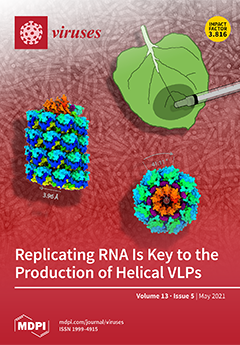Open AccessArticle
SARS-CoV-2 Infections and Viral Isolations among Serially Tested Cats and Dogs in Households with Infected Owners in Texas, USA
by
Sarah A. Hamer, Alex Pauvolid-Corrêa, Italo B. Zecca, Edward Davila, Lisa D. Auckland, Christopher M. Roundy, Wendy Tang, Mia Kim Torchetti, Mary Lea Killian, Melinda Jenkins-Moore, Katie Mozingo, Yao Akpalu, Ria R. Ghai, Jessica R. Spengler, Casey Barton Behravesh, Rebecca S. B. Fischer and Gabriel L. Hamer
Cited by 135 | Viewed by 11381
Abstract
Understanding the ecological and epidemiological roles of pets in the transmission of SARS-CoV-2 is critical for animal and human health, identifying household reservoirs, and predicting the potential enzootic maintenance of the virus. We conducted a longitudinal household transmission study of 76 dogs and
[...] Read more.
Understanding the ecological and epidemiological roles of pets in the transmission of SARS-CoV-2 is critical for animal and human health, identifying household reservoirs, and predicting the potential enzootic maintenance of the virus. We conducted a longitudinal household transmission study of 76 dogs and cats living with at least one SARS-CoV-2-infected human in Texas and found that 17 pets from 25.6% of 39 households met the national case definition for SARS-CoV-2 infections in animals. This includes three out of seventeen (17.6%) cats and one out of fifty-nine (1.7%) dogs that were positive by RT-PCR and sequencing, with the virus successfully isolated from the respiratory swabs of one cat and one dog. Whole-genome sequences of SARS-CoV-2 obtained from all four PCR-positive animals were unique variants grouping with genomes circulating among people with COVID-19 in Texas. Re-sampling showed persistence of viral RNA for at least 25 d-post initial test. Additionally, seven out of sixteen (43.8%) cats and seven out of fifty-nine (11.9%) dogs harbored SARS-CoV-2 neutralizing antibodies upon initial sampling, with relatively stable or increasing titers over the 2–3 months of follow-up and no evidence of seroreversion. The majority (82.4%) of infected pets were asymptomatic. ‘Reverse zoonotic’ transmission of SARS-CoV-2 from infected people to animals may occur more frequently than recognized.
Full article
►▼
Show Figures






